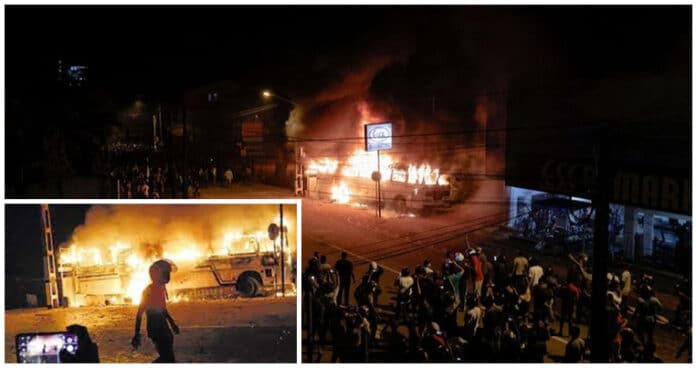Sri Lanka protests against the worst economic crises in the country’s history have been going on since 9th March 2022. Sri Lankan Prime Minister Mahinda Rajapaksa, whose family dominated politics for 20 years, was forced to resign by the mass protests on 9th May.
Government Supporters Disturb Peaceful Sri Lanka Protests
2022 Sri Lanka protests largely remained peaceful until government supporters started attacking the demonstrators with sticks and rods. Reportedly, Nearly 7 people have died, and more than 190 have been injured since then. PM’s brother, President Gotabaya Rajapaksa, imposed an island-wide curfew, but it could not stop the angry mob from retaliating. They attacked government supporters, officials, and properties despite the state of emergency, calling the President to step down as well.
Later in the night, the protestors started to burn the houses belonging to the Rajapaksa dynasty and its ministers. Several videos on social media showed how people were cheering as the luxurious properties of government officials were set alight, including PM’s ancestral home.
According to reports, the mob also attacked PM’s Colombo residence, where he was holed up with his family. However, the military was able to escort them out of there safely. The police told the media that the mob threw at least 10 petrol bombs into the compound.
What are the Reasons for these Protests?
Sri Lanka is going through the most terrible economic crisis since gaining independence from British Empire in 1948. The cost of living has become unaffordable, which has made the citizens furious. Besides severe inflation, there are daily electricity blackouts for 10-13 hours. The country has virtually run out of foreign currency reserves, and citizens do not have the buying power even for essential goods and services like food, fuel, medicine, etc. The government blamed the COVID-19 pandemic for the crisis. Coronavirus killed Sri Lanka’s tourism industry, one of its primary sources of earning foreign currency. However, many experts blame the government for economic mismanagement while using COVID as an excuse.
It eventually gave rise to Sri Lanka protests against the ruling party of the Rajapaksas family. Most protestors are non-partisan and do not support any political party. They mostly include the general public like activists, students, teachers, lawyers, engineers, doctors, farmers, sportspersons, and a few police officers who do not have any political affiliations. Their key demand is to get rid of Rajapaksas and pave the way for an entirely fresh bunch of qualified democratic leaders. Some politically affiliated groups also tried to start protests for their gain but eventually fell apart due to a lack of support. Sri Lankan youth has played a significant role in the ongoing protests. They have raised slogans like “you have messed with the wrong generation” and “don’t play with our future” to express their discontent with the dynasty.
How One Family Destroyed an Entire Country?
The economic crisis of Sri Lanka actually began in 2005 when the quitting PM Mahinda Rajapaksa was the President. After the civil war ended in 2009, Sri Lanka received foreign direct investments and portfolio investments from global capital markets. After that, the government recorded selected growth in infrastructure projects like highways, airports, and Colombo Lotus Tower, which was named the official landmark of Sri Lanka. However, they provided low returns because of corruption, as they only filled the pockets of wealthy businesspeople. Government critics, journalists, and activists started to get intimidated, disappeared, and killed.
Long before Coronavirus came to Sri Lanka, the economy was already struggling in 2018 and 2019. Moreover, it also had a history of poor performance in exports and declining revenue collection since the 1990s. It is because the politicians constantly exempted the wealthy from tax. Sri Lanka failed to make enough money to pay back its loans. Additionally, the Rajapaksa focused on facilitating cronyism and divisive ethnonationalism rather than using resources to address shortcomings. It suppressed minorities like Tamils in the east and north, who were already depressed economically. Furthermore, it supported the Indian government’s anti-Muslim campaign that somewhat started 2 years before the arrival of the Modi government. It also passed the 20th amendment to the Sri Lankan constitution, which took away power from critical institutions like the National Audit Office (NAOSL) and the Commission to Investigate Allegations of Bribery or Corruption (CIABOC).
The economy took another massive hit after the Rajapaksa government abruptly banned the import of chemical fertiliser. It said that the move was due to embracing organic fertilisation to fight the fertiliser mafia. However, many economists saw the decision as the government’s attempt to hoard dollars. The ban proved detrimental to the entire agriculture chain, disrupting the paddy harvest. In order to support farmers, the government had to start an expensive food aid program. Tea exports, Sri Lanka’s key revenue source, also dried up, resulting in protests that forced the government to lift the ban partially. However, the flawed policy eventually led to a shortage of essential goods, sparking mass Sri Lanka protests 2022.


